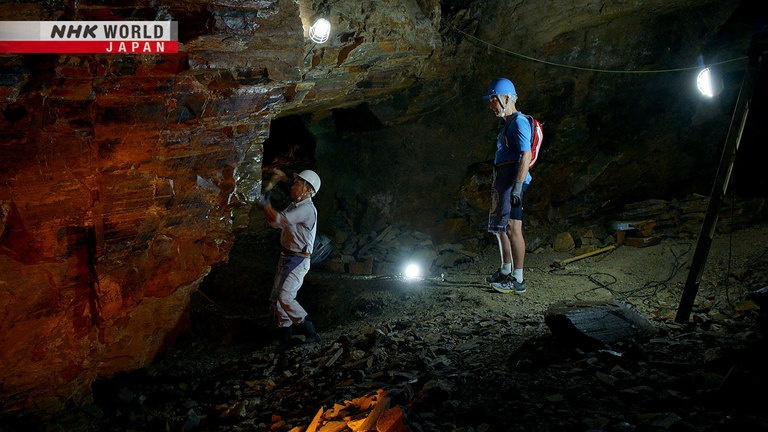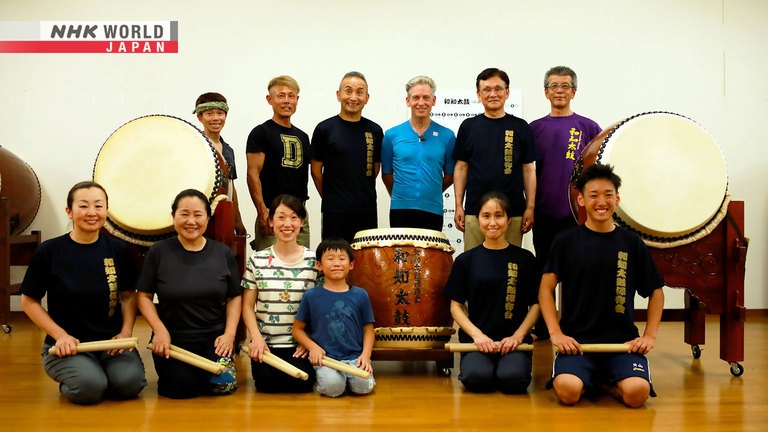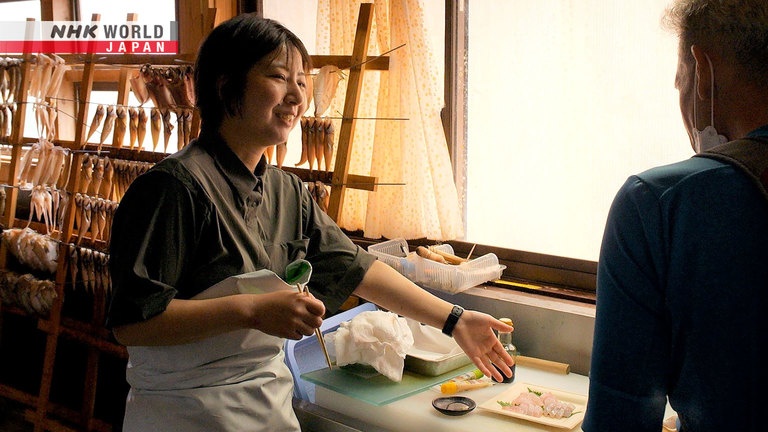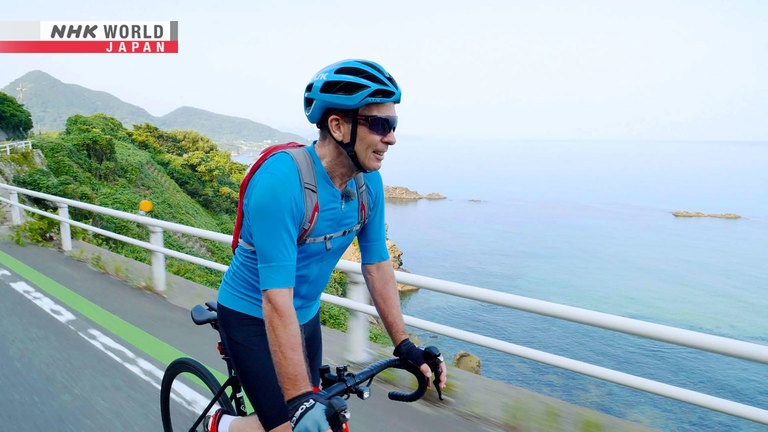Into the Kyoto Countryside
A 400km ride through Kyoto – the prefecture, not the city. Farms in this lush countryside supported the ancient capital's unique cuisine and tea culture, while artisans used local wood and stone to craft tools for Kyoto artists. We take tea in an 800-year-old teahouse, go deep in the forest with a whetstone craftsman to mine for stone, experience a 1,000-year-old drumming tradition, and finally, on the Sea of Japan coast, hear the story of a mother and daughter selling fish from their mobile store.




Transcript
The best way to discover little-known sights and make even familiar places feel brand new,
is to go exploring by bicycle.
Our road this time takes us to Kyoto.
Japan's ancient capital is one of the world's great tourist destinations.
But few leave the city to explore surrounding Kyoto Prefecture, a fascinating region in its own right.
The wind!
Out in the country, life proceeds at a very different pace.
These people have not forgotten their roots, or how to work and play together.
You're not holding back.
People here rely on inner strength to overcome adversity.
This is a very fine rock.
Unbelievable.
Come with us now, on a 400-kilometer ride through the beautiful countryside of Kyoto Prefecture.
We set off from the heart of the ancient city itself.
Starting with a quick prayer for a safe trip at Kodaiji temple, founded in 1606.
Kyoto - it really is a spectacular place.
It's just breathtaking.
Paul Imperatrice is from New Zealand.
A lifelong passion for eastern philosophy and martial arts brought him to Japan 32 years ago.
Paul lives in Tokyo, where he runs his own English school.
So off we go. Another adventure begins.
It's a very clear day.
Direct sun.
And Kyoto is in a basin so it's extremely hot.
And just amazing sights.
Look at the size of that.
This is a bigger, natural river.
Oh wow.
The Kamo River runs right through the heart of Kyoto City.
It gives it a very traditional feel.
It breaks up the harshness of modern cities.
Kyoto was built 1,200 years ago in a basin surrounded by mountains,
so leaving the city in most directions involves quite a climb.
Wow, tea.
I didn't expect to see that here.
Very well-manicured.
Wow, look all over there.
40-kilometers cycling has brought Paul to the lush tea plantations of Wazuka.
With gentle breezes and large temperature differences between day and night, this area is ideal for tea growing.
Riding on, we soon come to Uji, the famous tea manufacturing center.
Paul has worked up quite a thirst, and here's a convenient teahouse just past the bridge.
- Good morning.
- Welcome. Come in.
- Your teahouse has such character.
- Thank you.
Tsuen Yusuke is the 24th head of the family that's run this teahouse for over 800 years.
The Tsuen family were originally in charge of managing the bridge to Uji.
They opened this teahouse to serve travelers crossing the river to buy the town's famous teas.
Those are family heirlooms.
That's my ancestor who founded this teahouse.
When I whisk the first tea each morning,
I set a bowl in front of Tsuen's statue.
It's to thank him, and all the generations
of my family who ran this teahouse.
Tea, of course, became a central part of Kyoto life and culture.
Here we experience the country roots of that tradition of civilized hospitality.
What a beautiful color!
Today is such a hot day for cycling,
I thought you'd prefer it on ice.
- It's so fragrant.
- Yes, that's a big point.
It's very fluffy because of the powder and the bubbles. It's very light.
It fills up the mouth very well and not bitter at all.
Well, right now I have 4 young kids.
I look forward to seeing them take over the business.
Maybe they'll expand overseas?
Heading west from Uji brings Paul into an area of forested hills.
Paul has now come to Kameoka.
Ah, this is it here.
- Hello!
- Hello.
Tsuchihashi Yozo is an artisan who crafts whetstones, traditionally used for sharpening knives and bladed tools.
Stone mined here in Kameoka is extremely fine grained, giving it the quality needed to hone the sharpest blades.
I start with a rock like this.
Tsuchihashi selects different rocks to suit each application, whether it's chef's knife or craft tool.
From this 10-kilogram block, he'll end up with about 2 kilos suitable for crafting whetstones.
Go on, have a feel.
People compare it to a baby's skin.
- Feel how gentle it is on your cheek.
- That's amazing.
Have a try yourself.
Feels good, eh? So smooth.
Tsuchihashi has invited Paul to see where he mines the rock to make his whetstones.
This is a lot more serious than I thought.
Here we are!
- Quite a blast of cold air.
- Yes, it's chilly in there.
Come on in.
Here we are. Take a look around.
This is the rock I use for my whetstones.
This cave is now 15 meters tall and 30 wide.
Tsuchihashi excavated it entirely by himself.
- This is how I work.
- You do everything yourself?
- Just me, with my hammer and chisel.
- Unbelievable.
- It took over 30 years to get this far.
- Up to here?
Any kind of mining machinery would damage the delicate rocks, so Tsuchihashi does everything by hand.
- Now it will all just break off.
- Just like that?
Here it goes.
Beautiful, eh?
Look at this lovely chunk.
Unbelievable.
That will sharpen any kind of blade.
Tsuchihashi was born into a family that had made whetstones for four generations.
Even as a child, he longed to continue the family tradition.
But from the 1950s, cheaper artificial whetstones took over.
And at the same time, supplies of natural stone started running out.
In this difficult period for the craft, Tsuchihashi never gave up his dream.
He kept searching for stone, finally discovering this mine.
If I hadn't found this vein of ore,
I'd have had to give up the craft.
It was the first time my father ever
praised my work: "You did well, son."
He wasn't the kind to give compliments,
and I'll never forget those words.
The spirit that supported Kyoto's culture throughout history.
Nice and sheltered.
This is cool.
Paul has now left Kameoka and is heading up into the Tamba Highlands.
For over a thousand years, these dense forests supplied Kyoto's artisans with the superb timber they used
to make their city into an architectural masterpiece.
This is the Wachi district of Kyotamba.
Beautiful old building.
Drumming noise from inside.
Wow. That's sounding pretty powerful.
The local drumming tradition known as Wachi Daiko has a history going back 1,000 years.
This group rents space in an old school to practice twice a week.
Legend has it that the villagers began drumming to spur on warriors in a battle against demons attacking Kyoto.
Fujimoto Yoshikazu has been playing the Wachi Daiko drums for 55 years.
- I started in high school and I'm now 72.
- That's amazing.
The group has transcribed the traditional rhythms to make them easier to learn.
This is the base rhythm.
You come in here.
- And that's it. Simple.
- Simple?
Paul will try his hand at the most basic pattern.
I'll play the baseline. Get ready.
- No! Stop!
- Sorry.
- OK, this time for real.
- That's the spirit. Go!
OK!
That was great. Thank you so much.
- You did well.
- All thanks to his instruction.
I never thought I'd get it.
Such fun - and a whole body workout.
The group welcomes anyone, regardless of age or skill, and includes several local schoolchildren.
- How long have you been drumming?
- About a year.
Wow. You were really good.
One day you'll be as good as the teachers.
I hope so.
Wachi Daiko requires total mental focus and perfect synchronization with your fellow drummers.
It's an inspiring thing to experience.
For me, drumming is a kind of prayer.
When you pour your whole spirit into it,
it becomes a healing, a purification.
Something we need in these pandemic times.
Drumming keeps us healthy and strong,
and gives energy to everyone who listens.
It's a very warm morning and I'm just dropping out of the forest.
Just a perfect day. Blue sky, lime green rice fields.
Today we're in the Tango region, bordering the Sea of Japan.
There it is.
The Sea of Japan. "Nihonkai."
Wow, that water is just unbelievably translucent.
That looks really inviting.
Very cool.
Paul's now in the fishing port of Taiza.
I might just stick my nose in here and see if I can see what's going on.
It's 8:30 am, and the daily fish auction has just started.
2,500 yen, 3,000 yen...
Buyers are bidding for the morning's catch, fresh off the fishing boats.
- Hello.
- Hello.
- Are you a fishmonger?
- That's right.
We buy fish here and prepare it in various ways.
Then we sell fresh and processed fish
From our shop on wheels.
Shimo-oka Chieko's family has been in the fish trade for over 50 years.
Lots of shellfish today.
Today they have 20 kinds of fish, sashimi and air-dried.
Chieko's mother Yukako knows exactly what their customers like.
- I'll tag along.
- Stay close behind us.
I'll do that, thanks.
They'll spend the whole day driving around this small town, selling to its 2,000 residents.
Hello there!
Their first customer runs a clothing shop.
The mobile store is a boon for people who can't leave their work to buy food.
- I'll have one of these, and one of these.
- Thank you very much.
That will be ¥1,700.
- Do you often buy from her?
- Every week.
So many shops closed when the owners died
with no one to take over.
Mobile stores like this are a blessing.
In places with an aging and declining population, mobile stores also provide human contact.
Chieko's father Tomoaki had been running the family business for decades.
Sadly, Tomoaki passed away three years earlier, after a sudden illness.
He fought the disease for a month,
but in the end he lost the battle.
He never wanted to stop working,
but nature had other ideas.
All our customers loved him.
They begged us to keep the store going.
Chieko had been working in Osaka, but she came home to help her mother keep the business going.
As an only child, I couldn't leave
my mother to handle things by herself.
I just felt I had to do whatever I could.
Every day she does this job, Chieko feels a stronger connection to her hometown.
Any sandfish today?
These are very tasty.
I went to school with him.
Pals from nursery school.
- He's a really expert skin diver.
- I brought some big turban shells for you.
Really? That's great!
This is amazing. I can barely hold it.
It's as big as my fist.
Thank you very much.
The better I got at doing it,
the more I liked the fish business.
I only started because dad died,
but now I feel it's my real calling in life.
Paul will ride up from the coast to the top of Mount Gorogatake.
I wasn't sure how my legs were going to hold out.
I wasn't expecting this much climbing.
Wow, what a view.
A spectacular view, to end a spectacular trip.
Kyoto is full of beautiful scenery, just breathtaking rivers, rice paddies.
It's a really amazing place.
What I became aware of on this trip was that no one can avoid the hardships or difficulties of life.
But this suffering can be magically transformed through genuine communication and simple acts of compassion.
Not only can these acts alleviate the hardships,
but also provide the givers with a greater feeling of satisfaction and happiness in their own lives.
People down here really smile.
They smile from their heart.
That will be an image that stays with me for a long time.
From family and friends, we gain joy and the strength to overcome life's hardships.
A simple truth that the people in Kyoto's countryside have never forgotten.